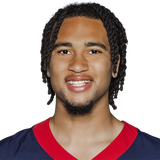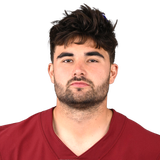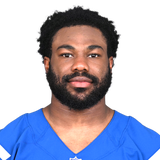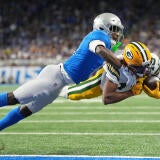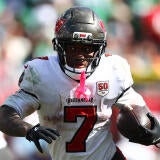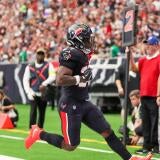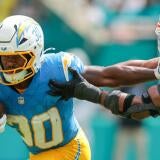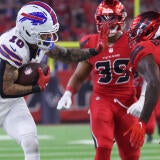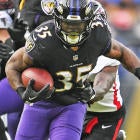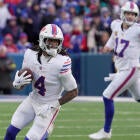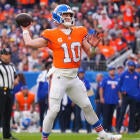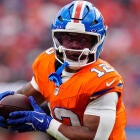NFL Fantasy Football Week 9 Lineup Decisions: Starts, Sits, Sleepers, Busts to know for every game
Dig into the players who might be tough start/sit calls in your lineup and who could be the breakout stars everyone wants in Week 9

Fantasy Football is all about the matchups. Even though you drafted your team with certain hopes and intentions, your weekly lineup decisions shouldn't be determined by the order you picked your players in. You need to check who your players play and make sure you've got the right guys in -- and the wrong guys out.
It's too early to be absolutely sure on which matchups will be easy and which ones will be tough, but we can take some educated guesses based on healthy personnel, defensive schemes, track records and key details of offenses. The things we know can help us minimize the impact of the things we don't know. This should lead to better decisions being made.
We'll go through every game and highlight the players who aren't obvious starts and sits (because you don't need to be told to start Justin Jefferson). You should feel more comfortable starting or sitting players based on the information given, and feeling comfortable with your Fantasy lineup before the games start is the best feeling in the world.
It's also important to have a keen eye for matchups dictated by the remaining schedule. I am now updating my projected Strength of Schedule rankings broken down by position available on SportsLine. My objective is to break down how the schedule affects every Fantasy relevant player for the upcoming four weeks, the playoff stretch and the entire season. You'll also be able to find my key takeaways on which players you should buy low, sell high and more trade advice.
It's tough to trust Levis in his second NFL start knowing the Steelers will try to pressure him relentlessly. Being on the road on a short week hurts too, but to me the larger factor is his pass volume -- how much will he have to throw in what might amount to a low-scoring slugfest against the Steelers and their suspect offense? Some quarterbacks I feel better about starting include Sam Howell and Derek Carr, but line Levis up against any other risky QB, from Geno Smith to Daniel Jones to Jordan Love, and his upside is ahead of theirs.
| ||||||||||||||||||
LAST WEEK: Looked like anything but a rookie against a Falcons defense that had been playing well but got outclassed on deep throws. He averaged a throw 15-plus Air Yards once every 3.6 pass attempts, he completed 3 of 8 of them (that's not bad), and on the day he threw off-target on just 6.9% of his throws while getting pressured on 40.6% of his dropbacks. He was much better than expected.
AS AN ASIDE: One positive effect of Levis' deep-ball success was the limited number of eight-man boxes Derrick Henry faced. The 36.4% of his runs with stacked boxes were tied for the second-fewest he's seen this year. As soon as Levis connects on anything deep against the Steelers, Henry should have fewer looks like this. It's just another reason why Levis is a good option for the Titans.
FILM: Levis' arm strength and quick release were trademarks of his at Kentucky and they were on display last week. His footwork was a liability in college but he's improved a little bit on it. There were some accuracy issues that his receivers made up for, and we had some debate here over how quickly he processed his reads. But overall he had mostly good ball placement on longer throws and made good decisions most of the time. Again, much better than expected.
TITANS PASSING: Levis' 29 attempts last week were the third-most for any Titans quarterback this season -- and would have ranked tied for seventh-most for any Titans QB last season. For them, it was a lot. That's an issue for Levis.
STEELERS: Are a step-up in class for Levis, especially with Cameron Heyward expected back from Injured Reserve. The Steelers blitz at the sixth-highest rate (37.3% of snaps) and have really revved that part of their defense over the past three weeks. They are a little better than league average in pressuring the quarterback (36.2%), though they have not been able to improve their pressure rate even with the extra blitzing lately. Heyward's return should give them a boost.
PRESSURE: Levis was 4 of 11 passing (36.4%) for 42 yards and the touchdown to Westbrook-Ikhine when pressured last week, a colossal difference from the 15 of 18 (83.3%) for 196 yards and three scores when he was not pressured.
DEEP BALL: The Steelers have struggled with deep throws, seeing on average 8.1 pass attempts per game of 15-plus Air Yards and 4.3 attempts per game of 20-plus Air Yards. The 49.2% completion rate allowed on those 15-plus Air Yard bombs is ninth highest in the league, and five of the 10 touchdowns they've allowed have come on those shots. Not having Minkah Fitzpatrick is a liability.
Ultimately it's hard to sit Hopkins after he erupted last week, plus four teams are on bye this week. But there is some obvious downside if Levis gets exposed, or if Derrick Henry's hand catches fire. It's why he's no better than a low-end WR2. I'd rather go with DeVonta Smith, Chris Olave and Zay Flowers.
| ||||||||||||||||||
LAST WEEK: Decimated a tough pair of Falcons outside cornerbacks with excellent route-running, good speed, terrific ball tracking and even some nuanced hand placement and jostling for position to help reel in 4 of 6 targets for 128 yards and three touchdowns. It's worth pointing out that one of the catches was a red-zone crossing route that Hopkins nabbed in traffic and sped 10 yards to the end zone with.
TARGETS: Hopkins saw 22.2% of Levis' targets last week and has been above 20% of the Titans target share every single game this season. That sounds wonderful but if you read the notes on Levis you'd know the Titans don't prefer to throw a ton. Hopkins has more than seven targets in two games this season.
STEELERS: Give up the fourth-most yards per catch to outside receivers at 15.5 and the sixth-most Yards After Catch per reception (YAC/reception) at 4.78. As for long completions, Pittsburgh ranks fifth-worst there with 15 gains of 20-plus yards allowed. All of these numbers work in favor of Hopkins as the Titans' primary outside wideout.
HOPKINS: All three touchdowns last week came against zone coverage, but elements of man-to-man coverage were ultimately involved in two of them (battling for position on a deep ball, out-maneuvering a defender on a crossing route). I mention this because the Steelers have played the third-most man coverage in the league over their past three games against the Ravens, Rams and Jaguars and might opt for more of it against the Titans to help pressure Levis as well as help deal with Henry in the run game.
STEELERS: Gave up monster numbers to Davante Adams, Nico Collins and Puka Nacua over their past five games (each had 20-plus PPR points), and Calvin Ridley (14 PPR points) and Zay Flowers (12 PPR points) also had solid games. The only perimeter receiver to truly struggle against Pittsburgh lately was Cooper Kupp, who has been out of sync over his past two games.
A case could be made for Rice to see an uptick in targets because Mahomes will likely have to throw short, which is how Rice has been used. But Rice isn't yet good enough to make multiple plays against quality coverage, something the Dolphins should have going for them with their secondary healthy. Rice remains an end-zone threat, but Mahomes' own track record against Fangio-coached defenses isn't strong enough to feel good about starting anyone in Kansas City's offense except Kelce. Assume Rice will finish with around 10 PPR points, a number Demario Douglas, Jahan Dotson and Michael Thomas should beat.
| ||||||||||||||||||
LAST WEEK: Continued his ascension in snap rate (season-high 61%) even with Justin Watson back from injury. He also played a little more in the slot than usual (60% of snaps), perhaps as a way to avoid non-stop confrontations with cornerback Pat Surtain (it didn't always work). But he had just five targets and a target share 15% or lower for the fourth straight game, and he was saved by a 39-yard catch-and-run before halftime. He also had an ugly drop on a wide-open slant late in the third quarter.
ADOT: Rice had a season-low Average Depth of Target (ADOT) of 3.4 yards last week. The week before it was 6.5, which was high for him but low in general. Rice continues to be used as a short-area target for Patrick Mahomes, someone who could come in handy in a matchup where Mahomes figures to be under pressure and/or see safeties playing deep to protect against big plays.
DOLPHINS: Got back Jalen Ramsey last week but he didn't really change their defensive identity. They've played a bunch of zone coverage for most of this year and have excelled at pressuring the quarterback without blitzing (38% of the time, fifth-best in pass rush pressure rate with only four rushers). That combination leads to all kinds of different defensive looks the Dolphins can give Mahomes. Getting Xavien Howard back at cornerback should further compel the Dolphins to try a bunch of different schemes against Mahomes.
FANGIO: In the five games Mahomes finished against Fangio while he was Denver's head coach, Mahomes had over 250 yards and multiple touchdowns twice. He had 20 or more Fantasy points three times but had over 25 points once (and he needed 54 rushing yards to help him). Fangio tried all kinds of coverage schemes but hesitated to blitz Mahomes in any of the games. Despite this, Fangio lost every single game.
Mattison continues to average a respectable touch total of 15.9 per game but is averaging a hideous 10.1 PPR points. Even in what seems to be a favorable matchup, Mattison doesn't carry a lot of upside to help Fantasy managers in Week 9. Tack on his seemingly rigid rotation with Akers and there's no promise as to how many numbers he will get. Sitting him is more about his game and the Vikings offense than it is the matchup. I'd rather start a Browns RB or a Rams RB.
| ||||||||||||||||||
LAST WEEK: Led the Vikings RBs in snap share (62%) and touches (16 carries, one catch), and even had a 60% edge in snaps inside the 10 over the Vikings other RBs, but remained totally ineffective as a runner with a 1.9-yard average. Three of his carries went for more than three yards.
AKERS: Rotated series with Mattison throughout the game and even had twice as many carries as Mattison in the first half (eight to four). Technically they continued rotating in the second half but Mattison played every snap of a 13-play drive, then Akers played on a one-snap drive (the Jordan Addison touchdown) before Mattison started the third drive, which lasted 14 plays. Akers started the second drive of the second half, which was well into the fourth quarter and lasted three whole plays (Akers didn't play third down). Mattison played the final drive which was eight snaps.
STATS: Look, neither running back is doing great. Mattison has avoided more tackles than Akers (16% rate) but neither has a high explosive rush rate and both have subpar rushing averages (3.8 or worse). Akers has a higher success rate on his runs (50% to Mattison's 38.7%), but that's not enough to push him into a primary role. Expect these two to keep splitting.
FALCONS: Allowed 5.2 yards per carry to the Titans last week after stud D-tackle Grady Jarrett got hurt in the early first quarter. It's the highest rushing average the Falcons have yielded in a game this year, but they haven't faced a slew of strong run offenses. New addition Kentavius Street should help the Falcons more on pass rush than on run defense. Maybe we see a slight bump in rushing production from the Vikings here.
VIKINGS: Will start rookie Jaren Hall at quarterback. This preseason Hall threw to his running backs on 14% of his targets. That's a low number, but it's still higher than the 10.4% and 12.8% target rates he threw to backs in each of his past two seasons at BYU. Not only is he not an upgrade for Mattison as a passer, but the Falcons are likely to dare Hall to throw on most early downs.
MATTISON: Has posted under 50 total yards in three of his past four games and has yet to score a rushing touchdown in 2023.
Metcalf has built-in potential because of the looks he gets from Smith not only on deep targets but on end-zone targets. But this is the second straight tough matchup for him, and the Ravens' skilled red-zone defense makes it less likely Metcalf comes through. And even if he does, his track record this year suggests it won't be a massive game. Consider him flex worthy; I'd rather start Josh Downs, Jordan Addison and Tyler Lockett in PPR.
| ||||||||||||||||||
LAST WEEK: Geno Smith beat the blitz to connect with Metcalf on a 43-yard bomb, but on five red-zone throws into or near the end zone, Smith couldn't connect. That's not all -- Smith was off-target a bunch on throws to Metcalf, as if the two hadn't played together in a month (it had been a week).
THIS SEASON: Metcalf has a 58.7% catch rate with 17% of his targets from Smith deemed uncatchable. That's not great. Metcalf also has one game this year with more than 15 PPR points.
GENO SMITH: When he's pressured, Smith has a higher target rate to Lockett (24.7%) than Metcalf (18.2%). Lockett also does better with those targets (68.4% completion rate, 10.5 yards per catch) than Metcalf does (50% catch rate, 9.4 yards per catch). Lockett also has a higher target share against zone coverage (22.6%) than Metcalf does (16.7%).
RAVENS: Rank about league average in pass rush pressure rate over the past three weeks (36.4%), getting the job done without blitzing much. They've also settled into playing more zone than man coverage over their past three games (77.7%, better than league average).
RED ZONE DEFENSE: The Ravens have allowed one touchdown and a fifth-best 35.7% catch rate to outside receivers in the red zone this year. The touchdown was against cornerback Ronald Darby in Week 2; Darby has since been relegated to minimal defensive snaps and special-teams duty.
No doubt this is a tough matchup for Edwards, but Fantasy managers should be encouraged by his play over the past couple of weeks. He seems safe to trust for a good workload and has the potential to score a touchdown against anybody. I'd start him over James Cook, Isiah Pacheco and either Packers RB.
| ||||||||||||||||||
LAST WEEK: Had an awesome matchup against the Cardinals and took advantage of his opportunities to score three times. He definitely cemented himself as the Ravens' lead RB moving forward.
PAST TWO WEEKS: Has averaged 16.5 carries per game and 1.5 receptions per game, dominating touches over the Ravens other RBs. He's averaged 4.4 yards per carry and landed a perfect 100% success rate on his carries inside the 5. Note that both games were blowout wins for the Ravens against NFC opponents.
VS. THE NFC: The Ravens are 2-0 this year and were 4-1 last year against NFC teams. The prevailing theory is that NFC teams aren't as prepared to handle Lamar Jackson and the Ravens offense as more familiar teams in the AFC are.
INSIDE THE FIVE: Edwards has converted 5 of 6 carries in short yardage into touchdowns including three goal-to-go carries from the 1.
SEAHAWKS: Have a 3.1-yard rushing average against RBs this season but over their past three games that number has looked like 3.9. Also, in 2023 they've allowed 5 of 5 carries inside the 5-yard line to go for touchdowns -- a 0 percent success rate for them. Adding D-tackle Leonard Williams should help in that regard but the Ravens have seemingly mastered how to handle their work from short range.
Njoku's Fantasy outlook turned on a dime when Deshaun Watson was named the Browns starter on Sunday. We've seen Watson lean on others in the short-area passing game this season, so until Njoku proves that his snaps with Walker are a function of the Browns offense on a weekly basis, he's just too tough to trust. I'd rather start Jake Ferguson and Logan Thomas.
| ||||||||||||||||||
PAST TWO GAMES: Njoku has been second on the Browns in target share (26.2%) and has turned a whopping 17 targets from P.J. Walker into a 9-131-1 stat line. He's posted 10-plus PPR points in consecutive games (and three of his past four).
WALKER: In fact, Njoku's three highest target games (at least seven in each) were with Walker, not Deshaun Watson. Njoku's been a short-area target in those games.
WATSON: The veteran is expected to start on Sunday, not Walker. That's not great for Njoku, who has seen just an 11.2% target per route run rate in three games and change with Watson this season. Njoku had under 9 PPR points in each of the Browns' first three games with Watson.
TARGETS: With Watson, Njoku has no more than four in any game. Meanwhile, Elijah Moore has had at least seven targets in each of Watson's first three games.
CARDINALS: Technically allow the third-fewest Fantasy points per game to tight ends, but they've seen so few big-time tight ends. Four they have seen -- Logan Thomas, Darren Waller, Jake Ferguson and Mark Andrews -- each had at least eight PPR points. One other stud, George Kittle, had one target while several teammates ran roughshod over other parts of the Cardinals defense.
This could be a good week for the Packers to try and let Love try more deep throws, but they'll need to protect him really well first. That's been a problem all year and figures to continue. Love has been relatively safe as a high-floor, low-ceiling Fantasy play, and that's where he lands for me this week. I wouldn't blame you for trusting him over Will Levis or Baker Mayfield, but both quarterbacks have more upside with maybe a little less downside. I'd happily start Sam Howell and Derek Carr over Love.
| ||||||||||||||||||
LAST WEEK'S FILM: Love seemed to lock on to his first read on most of his throws, which means if his first guy is covered the defense had a chance to sack him since he didn't come off his read so quickly and his O-line struggled. He had good mobility but you can tell the coaching staff really didn't want him to throw deep until it was sort of necessary (3.7 ADOT in the first half, then 5.4 in the third quarter and 17.9 in the fourth when they were really trailing). There were so many near-misses -- a deep throw on a scramble drill to Romeo Doubs, an end-zone fade to Watson, a go-route to Watson that the receiver slowed down on, a decision to hand off the ball on an RPO instead of keeping and throwing to a would-be open receiver in the end zone. It's just enough to tease you into starting him, but if you've done that over his past four games then you've been teased enough.
RAMS: Got shredded last week by the Cowboys passing game, which came alive after a rough start (three Rams sacks over the first four plays). Ultimately the Rams gave up points on six of their first seven drives. Dak Prescott was 9 of 12 on throws of 10-plus Air Yards for 179 yards and four scores.
RAMS: Have played zone coverage on 81.5% of their plays this season, eighth-most in football. They're consistent with it, so Love should expect to see plenty of it. Also, last week was the first time in five games the Rams didn't pressure a quarterback on at least 36% of their plays, and they blitzed plenty. It goes without saying the Rams should be expected to blitz a bunch in an effort to pressure Love into making mistakes with the ball.
LOVE: Has performed much better this year against zone coverage (63.6% completion rate, 7.1 yards per attempt, 9.7 ADOT) than man (38% completion rate, 4.6 yards per attempt, 8.9 ADOT). Where Love has struggled is when he's pressured, posting a QB rating of 47.0 and completing 42.1% of his throws.
RUSHING: It should be noted that Love has run for at least 21 yards in each of his past three games and five of his past six.
RAMS: Have allowed three big Fantasy games to quarterbacks this season -- Anthony Richardson (three total touchdowns), Jalen Hurts (303 yards, two total touchdowns) and Prescott last week (304 yards, four touchdowns). Everyone else has posted 15 or fewer Fantasy points including a hobbled Joe Burrow, Brock Purdy, Geno Smith and Kenny Pickett last week.
With the expectation that the Buccaneers won't be effective running the ball, expect Mayfield to have another game throwing plenty of times. That's what separates him from other questionable quarterbacks this week -- Will Levis, Jordan Love and Daniel Jones may not throw as many passes, plus none have the track record that Mayfield has this season. That's why I'd settle on Mayfield over any of them this week.
| ||||||||||||||||||
LAST WEEK: Mayfield threw a touchdown in the last three minutes (an underthrown pass to Mike Evans) that made the game at Buffalo look closer than it actually was. Before that play he completed 21 of 37 passes for 193 yards with one score. Luckily it all counts in Fantasy.
BUCCANEERS: Have basically given up on trying to run over their past three games, going with a league-high 70.7% pass rate. That in turn has led to Mayfield averaging 40.3 pass attempts per game, 7.7 of which have gone to his running backs, mostly Rachaad White. That's replaced the run game and have helped Mayfield pad his numbers.
MAYFIELD: Has really only had two bad games all season -- once against the Eagles on a short week, and another against the Lions. Two playoff-contending teams with strong defenses. They're also the only two opponents Mayfield had an ADOT higher than 8.0 yards in. Mayfield has 18 or more Fantasy points in each of his other five games.
ON THE ROAD: Mayfield has at least 20 Fantasy points in three straight road games.
TEXANS: Have started to implement much more physical man coverage in their past two games, and it's worked against the quarterbacks they've faced. Derek Carr threw for 353 yards but needed 50 attempts to do it and had one touchdown, and Bryce Young had a pedestrian day on just 31 attempts. Note: three receivers have had at least 15 PPR points versus Houston in those past two games.
PASS RUSH: The Texans are just above league average in pass rush pressure rate and pressured Bryce Young on just 15 of 40 drop backs last week.
MAYFIELD: Doesn't complete as many passes against man coverage (52.9%) than zone (66.7%), but he's a little more aggressive and doesn't have any turnovers against man-to-man. He's also barely competed against man coverage -- just 34 of his 246 pass attempts have come against that scheme. The same can be said of when he's pressured -- his completion rate isn't as good but he tends to be a little more dangerous.
There's actually some potential for White to be better than awful as a rusher, but the real reason why you'll start White is for his contributions in the passing game. Expecting at least five receptions isn't crazy as his receiving work has been baked into the Buccaneers offense. It's reasonable to expect 70 total yards with it, making White a good start in PPR leagues but a low-end RB2 in non-PPR. I'd take him over Alexander Mattison, Brian Robinson and the Rams RBs.
| ||||||||||||||||||
LAST WEEK: Continued to be more useful as a pass-catcher than as a running back, collecting a team-high seven receptions for 70 receiving yards at Buffalo. White also had nine carries for 39 yards, his second game this year with over 4.0 yards per rush. He had a season-high 22.6% target per route run rate. It was his second game with over 9.9 non-PPR and 15 PPR points.
ZONE BEATER: All but one of White's targets in his past five games have come against zone coverage. Mayfield has frequently checked down to White when his receivers are covered further downfield. And opposing teams have played a ton of zone coverage against the Bucs this year -- only the Saints dabbled in more man-to-man than the rest of their opponents. White had three catches for 22 yards, and 10.8 PPR points, in that game.
TEXANS: Have stopped playing heavy zone coverage in their past two games against the Saints and Panthers. Carolina didn't bother to lean on their backs (four RB targets) but New Orleans sure did (eight targets for Alvin Kamara, two for Kendre Miller). Of note: Kamara averaged a four-week-low 5.1 yards per catch against Houston.
PASSING GAME: On the season, Houston has allowed an 83.3% catch rate and 8.5 yards per catch to running backs, both bottom-10. Houston has also missed 13 tackles on these plays, which ranks fifth-most. It's a good set-up for White.
JUST SO YOU KNOW: Houston is affording 3.4 yards per run to RBs on the season and are top-three in defensive rush EPA. The only glaring issue is the 43 missed tackles they have on runs, the second-most. White has an avoided tackle rate of 18.5%, which is slightly better than league average among qualifying running backs.
The Buccaneers have given up some big numbers lately, but it's been to good quarterbacks (Josh Allen and Jared Goff) who threw at least 40 times in high-functioning offenses that either chose to or had to ignore their run games. Stroud and the Texans are a different story. If I had confidence in Stroud overcoming the pass rush and hitting targets deep downfield I'd feel better about starting him. Instead, he's on the fringe of being a QB1 for me this week. I feel much better starting Sam Howell, Derek Carr or Gardner Minshew.
| ||||||||||||||||||
LAST WEEK: Stroud continued to rein in his pass attempts, throwing 24 times for 140 yards without a passing score. He did dive for a one-yard touchdown. The 5.82 yards per attempt were his lowest since his first game.
FILM: Carolina played zone coverage exclusively so as to not get beat deep, and it basically stunted Stroud's options. He attempted just seven passes of only 10-plus Air Yards, his lowest of the season, and he completed two. Timing and accuracy were issues for Stroud as he overshot Nico Collins on a deep target early then was late and wide on another deep throw to Collins. Ultimately he was off-target on 16.7% of his throws and didn't get the chance to test the Panthers much even on intermediate routes.
BUCCANEERS: Coach Todd Bowles has the track record of being a mega-blitzer but his krewe has cooled off on blitzing over the past four games (32.7% blitz rate, 12th-highest in football but it's just basically well-above average). A side effect of that is the fourth-lowest pass rush pressure rate of 27.9% in those games. Not surprisingly, the Bucs have lost three straight. It wouldn't be shocking if Bowles dialed up more blitzes against a suspect Texans offensive line.
STROUD: Has been pressured on roughly a third of his dropbacks and has struggled on them, completing under 50% of his passes for 4.7 yards per attempt and zero touchdowns. This is just more evidence that the Bucs should not take it easy on Stroud and try to make him get rid of the ball quickly.
O-LINE: Since getting Laremy Tunsil back at left tackle, Houston has allowed a pass rush pressure on just 26.1% of their pass attempts, third-best in the league in that timeframe. But that's weighted down by the Falcons complete inability to get to Stroud in Week 5 (a 14.3% pass rush pressure rate allowed, which is incredibly low). Regardless of these results, Stroud has been below 19 Fantasy points in each game.
Singletary is a decent start if you're in need of a running back who should get at least 12 touches. But that might mean just 60 to 70 total yards, and between the Bucs' ability to curb the run (zero rush TDs to RBs) and the Texans' struggles with the run (two rushing touchdowns on the ground, one by Pierce and one by fullback Andrew Beck), this feels like an option with low expectations. I'd rather start either of the Browns' top two RBs, Darrell Henderson, Zack Moss and Brian Robinson.
| ||||||||||||||||||
THIS WEEK: The Texans ruled out Dameon Pierce, opening the door for Devin Singletary to be the Texans' lead running back. Up to this point Singletary and Pierce had been splitting first and second downs with both backs and Mike Boone working third downs. Boone should handle most if not all third-down work with Singletary handling the rest.
TEXANS: Have averaged 21.7 RB runs per game this year, seventh-most, but at 3.2 yards per carry rank third-worst in average. Their offensive line issues, which continue on this week, contribute to that.
SINGLETARY: Has averaged 3.7 yards per run, which is nearly a yard better than Pierce (3.0) but still ranks 37th out of 55 qualifying running backs this season.
BUCCANEERS: Have yet to allow a rushing touchdown to a running back this year. Only four backs have scored at least 13 PPR points on the Bucs, all of whom had at least 14 touches. The only one to get more than 15 PPR points was Alvin Kamara, who had 13 receptions.
Howell proved last week that he can crush good defenses when he isn't pressured, now he's taking on one of the least pressuring defenses in the league. He also should throw a good amount of the time, possibly seeing 35 attempts because the Commanders run game could struggle. Howell fits in as a top-10 Fantasy quarterback this week. I'd start him over Derek Carr, Gardner Minshew, Will Levis and Geno Smith.
| ||||||||||||||||||
LAST WEEK: Howell put up his best game of the season, rocking the vaunted Eagles pass defense for 397 yards and four touchdowns. The 39 Fantasy points were a season-high for him, nearly 10 points higher than his previous high. Howell also completed 75% of his throws, also a season-high, for an almost-season-high 7.63 yards per attempt. He was outstanding.
FILM: Howell attacked the Eagles with quick throws early, then began blending in intermediate and downfield shots. The Eagles pass rush wasn't in his face enough and Howell threw with great accuracy. He also displayed incredible anticipation on deep targets to Terry McLaurin and Jahan Dotson, both for touchdowns. He did experience some drops, and a handful of overthrows led to some disappointing would-be touchdowns along with an interception. Again, a key factor was that he wasn't pressured as much as expected, and the end result was glorious.
PATRIOTS: Are one of the league's blitz-heaviest teams (fifth-highest rate in their past five games), but can't pressure the quarterback (second-lowest pass rush pressure rate in their past five games). They have five total sacks in their past four games. Three of the past four quarterbacks to face New England posted at least 19 Fantasy points; the one who didn't was Jimmy Garoppolo, who had 10 Fantasy points in one half.
BEST OF ALL: New England remains solid against the run, keeping RBs to 3.5 yards per carry. The Commanders, who have a pass rate of 68.7% on the season, may not be able to get their run game completely on track here.
HOWELL: Has scored 21 Fantasy points in 5 of 7 games. His only two bad games were disasters where he was pressured over 40% of the time against the Bills and Giants.
Howell proved last week that he can crush good defenses when he isn't pressured, now he's taking on one of the least pressuring defenses in the league. He also should throw a good amount of the time, possibly seeing 35 attempts because the Commanders run game could struggle. Howell fits in as a top-10 Fantasy quarterback this week. I'd start him over Derek Carr, Gardner Minshew, Will Levis and Geno Smith.
Last week was literally the first time Kmet was a regular target of Tyson Bagent's, and it came in a blowout loss when Kmet wasn't needed to block like he was in the previous two games. It's possible Kmet can find a similar game script this week and collect receptions to help his Fantasy numbers, but the Saints seem strong against tight ends and Kmet could run into trouble, as might his quarterback. Kmet is barely a starting option in PPR but I'd rather trust Trey McBride, Dalton Kincaid, David Njoku or Logan Thomas. Add Taysom Hill to that list in non-PPR.
| ||||||||||||||||||
LAST WEEK: Apparently the Bears didn't need him to block as much as he had been in his prior two games with Tyson Bagent, sending Kmet out on pass routes without any extra blocking much more often. He came alive in the second half when the Bears were down big as an easy short-area target, nabbing all six of his targets for 47 yards to go with his 4-32-0 stat line from the first half. Kmet led the Bears with a 27% target share against the Chargers' zone coverage; it helped that the Chargers barely blitzed in the second half when they were comfortably ahead, freeing up Kmet to run routes.
SAINTS: Play the fourth-most man-to-man coverage in the league and have allowed the second-lowest catch rate to tight ends this season (60%) despite seeing the deepest ADOT (8.67 yards). New Orleans hasn't played many top-tier tight ends but only one they've faced has notched more than 10 PPR points against them, and he needed to score to do so (Dalton Schultz).
MAN-TO-MAN: Bagent has barely experienced man coverage as the Bears quarterback but has poor numbers against it compared to zone, including a grotesque 26.4 QB rating. Kmet's catch rate against zone coverage is 93.3% this season, 55.6% against man coverage.
If the Bears had more offensive creativity, or if Tyson Bagent was a better passer who used Moore a little further downfield, there would be enough there to confidently start Moore. But the worry is that Bagent won't have the time to focus on longer passes for anyone in the Bears offense, much less the one guy the Saints are likely to try and take away. Moore is OK as a flex play, more so in PPR, but he's not a must-start guy like he was a few weeks back. I'd rather go with Nico Collins, Chris Godwin or Gabe Davis.
| ||||||||||||||||||
LAST WEEK: Against a Chargers pass defense that entered the week ranked dead-last in Fantasy points allowed to outside receivers, D.J. Moore saw a meager six targets for a 4-55-0 stat line despite 37 pass attempts from backup quarterback Tyson Bagent. That extended Moore's cold streak to three straight without 15 PPR points -- two and a half of them with Bagent.
FILM: Moore remained a predominantly outside receiver who saw a good dose of coverage tilted to his side until the game was out of reach for the Bears. But Moore also struggled at times with physical press coverage, slowing him in his routes. It didn't help that Bagent didn't have a lot of time to look for Moore, especially on third downs early on.
SAINTS: Have one of the league's feistiest cornerback duos with Marshon Lattimore and Paulson Adebo. Last week they gave up some high-catch numbers to Michael Pittman and Josh Downs, but neither had a particularly efficient game (Downs averaged 10.3 yards per catch, Pittman averaged 5.0 yards per catch with a touchdown). The longest completed pass for those two traveled 12 Air Yards.
BAGENT: Has targeted Moore on 26.3% of his throws over the past two-and-a-half games, which is great, and Moore has caught 16 of the 21 targets Bagent has thrown his way. The problem is that Moore's ADOT on those throws is a low 6.71 yards; only seven of those targets traveled 10 or more Air Yards and only three of the targets traveled 15 or more Air Yards.
RED ZONE: Since taking over as Bears QB, Bagent has led the Bears on six red-zone drives (three against the Raiders). On those drives, Moore has seen two targets from Bagent once in the red zone (both against the Raiders). To be fair, Bagent put a perfect ball on Moore running a fade but Moore had it knocked away. That's the closest Moore has come to scoring on a pass in his last 10 quarters.
SAINTS: Have allowed nine drives over their past three games to extend into the red zone with six of the drives ending with a touchdown. That's not so good for them but of those six touchdowns, three were scored on runs and a fourth by a tight end. The two receiving touchdowns were creative -- Michael Pittman went in motion and lined up like a tight end before running off an Alec Pierce pick for his short-yardage score, and Robert Woods lined up wide but ran a direct slant and remained uncovered. The only other WR touchdown let up by New Orleans was a 44-yard Christian Kirk catch-and-run.
HISTORY: Moore has a long track record of facing the Saints as a member of the Panthers. Last year he TOTALED two catches in two games against the Saints. He has scored under 6 PPR points in three straight against the Saints. He has five career touchdowns and two 100-yard games in his career against the Saints, but four of the scores and both of the 100-yarders came in 2020 or earlier.
Don't be surprised to see the Colts run wild over the Panthers -- we've seen them give 18 carries each to Moss and Taylor (that was two weeks ago against the Browns) and 29 total carries to them combined (23 for Moss in Taylor's first game back against the Titans). It should be enough to consider Moss in all formats as a RB2 ahead of the Packers RBs, the Rams RBs and the Bears RBs.
| ||||||||||||||||||
LAST WEEK: Both Colts running backs were awesome, but Taylor had a better rushing average, a better rate of runs of five-plus yards (41.7%!), a better explosive run rate (25%) and a better avoid tackle rate (33%). In Moss' favor was a 41-yard run where he escaped a stacked box and a short-yardage touchdown, lifting him to the better Fantasy day despite playing 39% of the snaps.
ROTATION: It looked like Taylor had a two-to-one series advantage, meaning he would play two series with Moss playing one series. The only time it felt like Moss had a specific role was near the goal line (he played 4 of 5 snaps there) and in the two-minute offense.
MATCHUP: Carolina is toward the bottom of every rush defense metric you could think of, including second-worst in yards per carry allowed (5.0), bottom-four in yards before contact and yards after contact per rush, bottom-five in explosive rushes allowed (9 percent of all runs), and bottom-four in missed tackles. The Panthers have also given up 12 rushing touchdowns to RBs, which is more than anyone else in football. Only the Texans struggled against the Panthers this season.
MOSS: Has at least 12 touches in each of four games since Taylor's return -- and at least 11 non-PPR points in three.
Meyers is a terrific receiver stuck in a bad spot. Will Aidan O'Connell be a better passer than when we last saw him? Will Meyers' role adjust at all to help O'Connell? Will the Raiders play it conservatively since the Giants offense doesn't figure to put up a ton of points themselves? We need a week to see how this shakes out, which is why I'd rather start Diontae Johnson, Josh Downs, Zay Flowers, Tee Higgins and Gabe Davis over Meyers.
| ||||||||||||||||||
WITH AIDAN O'CONNELL: Over 59 drop backs, O'Connell has targeted Meyers six times. That raw number ranks fourth behind Davante Adams, Josh Jacobs, and, somehow, Hunter Renfrow. Of those six targets, half were caught for 42 yards and a touchdown, the only TD O'Connell has thrown so far this season ... and it came in a blowout loss at Chicago.
THAT SOUNDS BAD, BUT: Meyers is still a clear second on the Raiders in target share (above 22%, which is good) and leads the team in receiving touchdowns with five. He's not going to become invisible because of the quarterback change nor the offensive philosophy change.
AND ALSO: O'Connell has been gun shy, averaging 6.8 yards per throw with 15.4% of his throws going 15 or more Air Yards. And he's also struggled when pressured, though that hasn't happened much because he was barely blitzed in his only start against the Chargers.
GIANTS: Expect pressure -- the Giants are second in the league in blitz rate and ninth in pass rush pressure rate, factors that helped them keep the game close against the Jets last week despite not having a functional quarterback. Only twice in their past seven games have the G-Men not had a blitz rate over 40% -- and only once in their past seven games have then not had a pass rush pressure rate over 40%. They get after it and they've played good coverage behind lately too (one touchdown to a wide receiver over their past three games, and it was to Deonte Hardy.
ADOT: Meyers has a season-long ADOT of 10.3, but he's been above that number in three straight games. With O'Connell in Week 4 it was 10.0 yards even. He may be asked to work even shorter range this week to give his quarterback a chance to connect when he's pressured.
If you start Cooks, you're hoping the Cowboys harness his speed and take some shots with him against a suddenly susceptible Philadelphia secondary. Given the likelihood of a high-scoring game, Cooks could get involved more than usual as a change-up to CeeDee Lamb. Cooks is a risk worth taking over Michael Thomas, Tyler Boyd, Rashee Rice and Nathaniel Dell.
| ||||||||||||||||||
If you start Ferguson, you're hoping for a touchdown. That's really it -- Ferguson isn't used enough outside of the red zone to be counted on for good numbers, though any kind of high-scoring game could warrant more opportunities, especially if the Cowboys can't run the ball again. Ferguson is on the TE1 bubble ahead of Taysom Hill in PPR as well as Jonnu Smith, Hunter Henry, Luke Musgrave and Tyler Higbee.
| ||||||||||||||||||
LAST WEEK: Ferguson and Cooks each caught touchdowns as part of the Cowboys romp over the Rams. Neither had more than four targets or 50 yards to go with it as CeeDee Lamb played like a megastar. Dak Prescott only needed to throw 31 times.
THIS WEEK: The Eagles are likely to pull out all the stops to try and contain Lamb and force Prescott to throw to different places. When they're not in the red zone, Cooks' speed should be utilized against Philadelphia's cornerbacks, especially James Bradberry who has been getting beat more than we're used to seeing. When they're in the red zone, Ferguson typically comes alive as a short-area target who can bruise ahead for extra yards. Of his 33 targets this year, Ferguson has had 11 come in the red area.
THE CATCH IS: Cooks doesn't have more than four targets in any of the Cowboys' past four games, and he doesn't have 50 receiving yards in any game this season, and he has just three deep catches of 15-plus yards. But he looks as fast as ever on film. And Ferguson is really used as a red-zone and occasional check-down option. He has one game with over 50 receiving yards this season.
EAGLES: Allowed 8 of 12 targets of 15-plus Air Yards to be caught for 160 yards and three touchdowns last week. That's definitely going to get attention, especially since it was Sam Howell who threw those passes. On the year, no team sees more pass attempts of 15-plus Air Yards (9.4 per game) than Philly. Aside from allowing seven touchdowns on those plays, they're really good at containing targets (2.5 YAC/reception on deep balls) and allowing a catch rate below league average (42.7%).
EAGLES: Their red-zone defense against tight ends hasn't really been tested as only five such targets have been thrown against them. Four were completed, all for touchdowns, including one last week. It should boost the optimism for Ferguson.
It'll sting if you start Davis and the Bills go back to using him as a downfield threat more than a short and intermediate target. My guess, and it's just a guess, is that the Bills like the idea of playing up-tempo with so many explosive talents on the field. Davis also has been a reliable end-zone target all season, so even if the Bills do go for a slower pace or don't use Davis the same way he can connect for a score to help his numbers. He has just enough upside to be a low-end WR2 in PPR this week over DK Metcalf, D.J. Moore and Amari Cooper.
| ||||||||||||||||||
LAST WEEK: The Bills changed his role, not using him so much as a deep threat and instead relying on him as a short-area target. On a season-low ADOT of 6.67 yards, Davis flourished with a 75% catch rate over a season-high 12 targets for 87 yards and a touchdown. Hand in hand with that was a Bills decision to use quick passing, especially early on, to negate the Bucs pass rush.
WILL IT LAST? Last week's opponent played a bunch of zone coverage, which the Bills adjusted to with short throws for not just Davis but also Dalton Kincaid; Khalil Shakir wound up with a higher ADOT than Davis. There's a chance the Bills change things up again based on how the Bengals will play them.
BENGALS: Tend to play more zone than man coverage but are among one of the league's most adaptable defenses, willing to adjust their scheme to the weaknesses of their opponents. They're also excellent at making changes at halftime to fluster their opponents.
HISTORY: Through the first three quarters of last year's playoff game, the Bengals leaned toward zone coverage on first and second downs before going with man-to-man on 6 of 7 third downs. They let up from that in the fourth quarter when they were up by two scores.
DAVIS: Obviously thrived against zone coverage last week and has been doing the same against it all season long, averaging a 73.3% catch rate and 14.0 yards per grab. Davis has yet to score a touchdown beyond 10 yards against man-to-man coverage this season.
Johnston is beginning to trend in the right direction, but his lack of explosiveness is a little alarming. Pair that with a tough road matchup and it's impossible to feel good about starting Johnston. Keep him benched; I'd rather chance it with Josh Downs, Jahan Dotson or Demario Douglas.
|
LAST WEEK: Palmer's knee injury may have opened the door for Johnston to get more chances to connect with Justin Herbert against a bad Bears secondary, and he did. With L.A. aiming to get the ball out quickly, Johnston's ADOT plummeted from 21.29 yards in the three games prior to a much more reasonable 7.83 yards. He doubled his previous season-high in targets with six, more than doubled his previous season-high in catches with five, and nearly doubled his yardage over the entire season with 50. Palmer, meanwhile, seemed to be given the decoy duty in the wake of his injury with his worst numbers since Mike Williams' injury (3-24-0).
FILM: Johnston impressed on his timing with Herbert, being in the right place at the right time on an 11-yard hitch and again on an 18-yard go-ball in the fourth. He also made two defenders miss on a shallow crosser than turned a three-yard play into a 12-yard play. But Johnston did little to separate from coverage -- he was blanketed on an end-zone fade -- and when the Chargers went to two-receiver formations before Palmer's injury, he was off the field.
JETS: In most of their games this year outside receivers have caught the majority of their targets (over 70% in the first five weeks) but for low yardage (under 11.5 yards per catch in four of the five games). The defense keeps receivers in close contact with safeties generally nearby, and they're outstanding defending the deep pass. As a result, no wide receiver has caught a touchdown against the Jets on not just deep throws, but on any passes of over five Air Yards. Not that offenses are trying much -- throw out last week's nonsense against the Giants and the Jets have seen just 9.7 targets per game thrown to opposing receivers. Keep in mind, they've played the Bills (Diggs scored near the goal line), the Cowboys, the Chiefs, the Broncos and the Eagles.


























